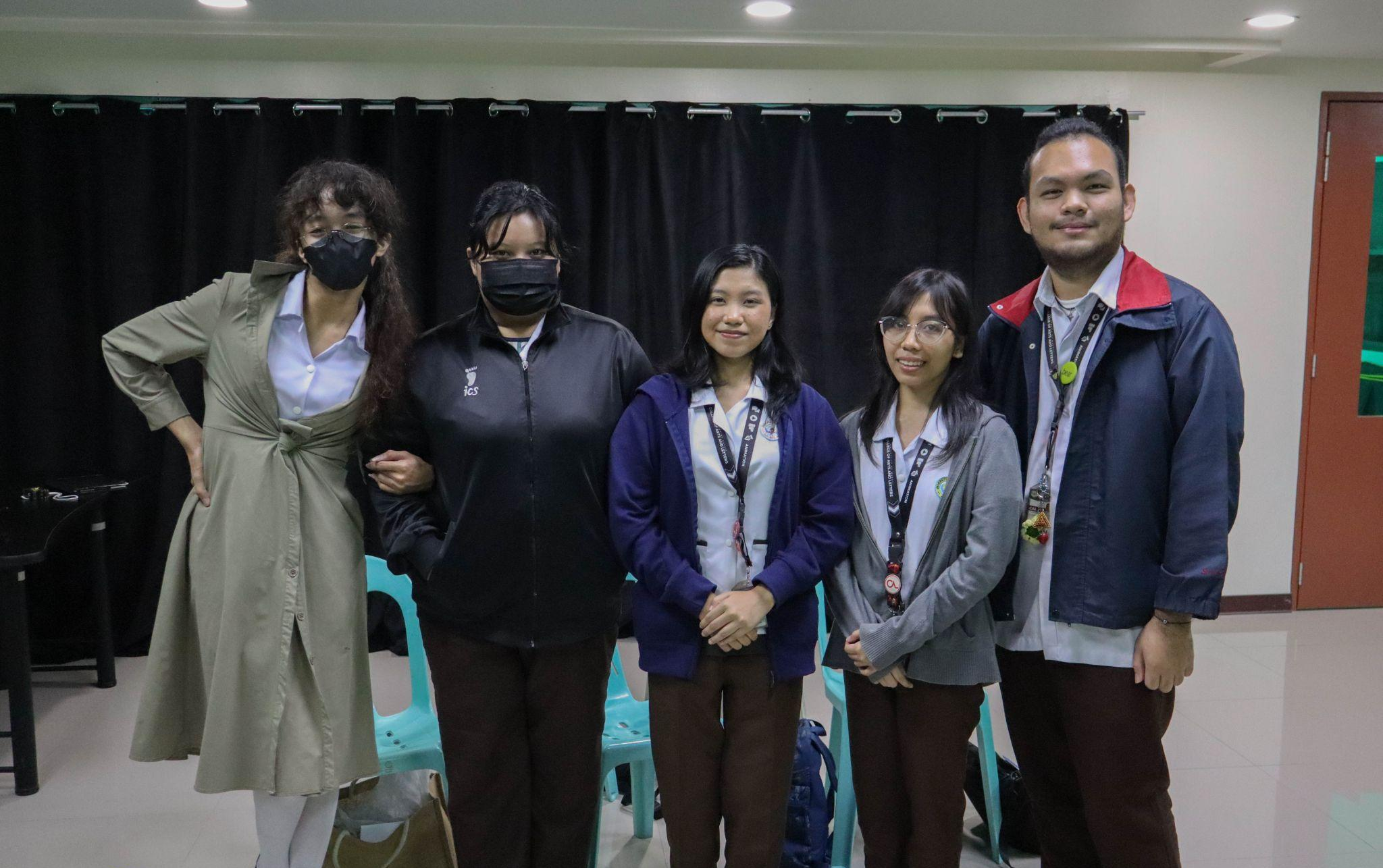A RETROSPECTIVE OF AN AWARD-WINNING SHORT FILM,
SAAN AABOT ANG 50 PESOS MO?
Innovation is motivation
The 50th Metro Manila Film Festival (MMFF) celebrated not only full-length feature films but also beamed a spotlight on emerging talents through its Student Short Film Competition. This initiative, in collaboration with the Film Development Council of the Philippines, aims to showcase the creativity of young Filipino filmmakers. In celebration of the Festival’s golden anniversary with the theme: “Sine Sigla sa Singkwenta", stories of the short film revolve around “50” which serves as a cornerstone for students to demonstrate their storytelling skills through the lenses of culture, personal experience and imaginative interpretation.
Gabi of Parangal, occurred on December 27, 2024, was a night of local talent. Among the standout entries was "Saan Aabot ang 50 Pesos Mo?" by 3rd year Animation students from the University of Makati, which clinched the Best Student Short Film award. This whimsical piece depicts the struggles and aspirations of Cinco, the protagonist, focusing on the value of a 50 pesos in various contexts.
WHERE THE FILM BEGAN
What do we know about the film’s origin? Think of it as a depiction of a real life predicament. Inspiration comes from the most unexpected circumstances, and for the creators, it came from a simple, yet frustrating experience—losing money. Michael Glenn Santos, the Assistant Director, recalled how he once found himself down to just 50 pesos during a group discussion. This incident sparked the idea for their film, which tells the story of a student facing similar challenges.
“The very reason why the film was produced is particularly for the students. They are the target audience,” Atty. Eduard Riparip, the team’s mentor, remarked.
Whether a film is truly remarkable relies on how much it impacts its spectators, for instance how potent is its relatability. That is precisely the trajectory of Anchovy Production, the artists behind the award-winning film, aimed for. In what way? Here goes a brief synopsis. From rushing to school in a jeepney and tricycle amidst the muffled honks of vehicles to losing the money which then followed by unimaginable misfortunes, Cinco’s journey is one many can identify with. The film's distinct attributes are things we see on a daily basis. Its milieu, Cinco’s UMak school uniform and his endeavors helped make it resonate with the audience as it portrays a reflection of student life we could relate to. 000
“We want people to watch and think, ‘Oh, I’ve been through that’,” said Santos.
It is a story deeply rooted in reality. Selina Claire Napano, the Director, remarked, “We want it to look very Filipino. Not just in looks, we want it to feel very Filipino. Environment wise, character wise, story wise.” One distinct scene in the film depicts universal experience amongst Filipino students. Imagine going through drastic exhaustion on the way to your university just to get slammed by last minute suspension. It is a scenario that anyone well aware of the Philippine education system can instantly recognize. Pinoy indeed in all forms! The cinematic execution of these elements has no doubt mirrored local urban life especially of a student’s.
Now here’s a fun trivia. The team’s decision to use an anthropomorphic cat as the protagonist was not only a creative choice, it is inspired by UMak’s beloved stray cats and a nod to the stray cats roaming the streets of Philippines. Simply wholesome. Not only does a cat being the main character serve as entertainment to entice the audience, it is also a thoughtful approach as it gives underprivileged cats a tribute.
METAPHORS BEHIND THE VISUALS
In light of the underlying connotation, there lies the rhetorics of financial importance, punctuality, situational awareness, persistence and reverence.
Financial importance is the film’s forefront. Where exactly would 50 pesos take us in today’s economy? This sum, which once had sufficient purchasing capacity, now struggles to stretch across necessities. As Kirsten Jersey Dela Cruz aptly pointed out, “Money nowadays is of high value. Everything is very expensive… with salary being [inadequate].” This sentiment encapsulates the core of the film. The rising cost of living, paired with stagnant wages, is a situation many individuals have to live through. “Saan Aabot ang 50 Pesos Mo?” does not just highlight these conflicts, it also explores the emotional toll that these financial constraints have on families. By making money a central narrative element, the short film emphasizes how financial pressure shapes decisions in hopes to urge the audience to reflect on the value of every penny in an increasingly expensive world.
Punctuality is a noteworthy principle embedded in the film. The concept of rushed actions in response to tardiness is something students are very much familiar with. “It teaches us that not only money is valuable, but also the value of time and awareness in your vicinity,” Dela Cruz emphasized. Hypothetically speaking, had it been Cinco was not late, what are the odds of the adversities he went through not happening in the first place? It is due to time perception distortion that led him into chaos, which consequently touches the aspect of situational awareness. His distorted time perception compromised his sound thinking. The urgency he felt clouded his judgement causing him to act impulsively and overlook his surroundings. The more he panicked, the more he lost composure eventually setting off a chain reaction of missteps.
Persistence, however, is the heart of the story. Cinco’s steadfast pursuit of the bill is not only about the money, it is about refusing to let his mother’s sacrifices be in vain. Every setback could have been a reason to stop. But he did not. Because for Cinco, this is not just about chasing a piece of paper, it is about fighting for something he deeply treasures. “His determination and perseverance reflects a lot on who we Filipinos are. Despite our frustrations and struggles, we never give up and we persevere through those hardships that we still get down on our feet and we don't give up until our goals are achieved,” Arwen Ollague stated.
Chasing the money in itself portrays metaphorical situations. As he chases further, the more adversities he encounters. Blindly chasing money without a strategic foundation, bumping into people, causing inconvenience. But can Cinco be blamed? For him, the thought of losing such an amount is a manifestation of taking his mother’s hardships for granted. The film shows a thought-provoking scene of Cinco reminiscing about her efforts which urged him to reclaim the 50 pesos at any cost. Atty. Riparip remarked, “It reminds us that when we are about to give up, we have to go back to the very core of why we are doing it. We have to go back to the very essence.” In a way, this mirrors reverence—looking back and paying forward to what the parents have done.
LEARNING CURVE BEHIND THE SCENES
Throughout the process, the team gained both a monumental award and invaluable lessons. For Atty. Riparip, it’s the patience that blossomed within him. It has always been his virtue throughout his mentorship career. For Napana, what resonated to her the most is taking risks; for Santos, he learned the importance of adaptability; Dela Cruz and Ollague’s takeaway is willingness to accept criticism; Hannah Grace Ramoso learned more about teamwork and time management.
On the other hand, who's to say their collaboration was entirely smooth? When asked about team dynamics, hurdles and how they dealt with pressure, it was quite a rough patch. Creating a five-minute animated film is no easy feat, especially when given only 2-3 weeks to complete it. The team had to solve numerous obstacles; storyboarding mishap, clash of ideas, time constraint, sleepless nights and tight deadlines. Napano shared that they made tough decisions on the spot and had to cut some scenes to meet the deadline while maintaining quality. "You have to be creative around limitations. You improvise, keep it concise, and make sure it still resonates with the audience," she said.
Collaborations always have ups and downs. Miscommunications, revisions, and sleepless nights were part of the process but instead of letting the pressure break them, they leaned into their companionship. “We coped through humor,” Santos shared. “Yes, we were suffering, but we had fun along the way.”
For Anchovy Production, this was the journey they embarked on. A journey that not only led them to triumph but also prompted them to unveil deeper reflections about teamwork. That in itself solidified their bond with one another.
A REMARKABLE MILESTONE FOR BMMA-ANIMATION HERONS
It’s fascinating how the strokes of a pen can take someone to places. It seems as though life is an empty canvas where they visualize their way to success and bring it to life.
To have won a prestigious award is no doubt an exceptional accomplishment. More often than not, the best things come in the most unexpected moments. When the team submitted their film to the Metro Manila Film Festival (MMFF), winning was not their primary goal. They were focused on creating something for the sole purpose of academic requirement. Yet, to their surprise, they not only made it to the Top 10 but also secured the top spot.
There have been doubts but for Dela Cruz, she already had an inkling, “It’s something I expected not out of the blue… And I just really love the feeling of winning. Who doesn’t?” This is certainly the confidence needed in times of nerve-wrecking moments.
The director described the experience as surreal. “When they called our film, we couldn’t believe it. We were just happy to be there, enjoying the food, not expecting anything.” Santos added, “We were shocked. We thought there was no chance for an animation to make it to the Top 3. But there we were standing on stage, living a dream.”
From “always a nominee but never a winner” to “when we won, it felt like we were truly deserving,” that is precisely how it felt according to Atty. Riparip. Isn’t it mind-boggling? Out of all contenders, most of which are live-action and narrative documentary, an animation film sweeped the glory. Achievement like this, which particularly elevates a collegiate distinction, is something to be proud of. Thanks to the collective effort of Anchovy Production.
But why animation, you may ask. Atty. Riparip encouraged the artists to explore animation because of their expertise. On top of that, they are animation students. It was a befitting time to make use of their skill set for a bigger venture. And so they did. It truly is a remarkable milestone as they gain valuable lessons professionally and personally.
When an idea evolves into something impactful, that is where multitudinous learning opportunities begin to flourish. Speaking from experience, the team shared their advice to aspiring filmmakers.
“Be observant, be socially and politically aware with what is happening around the world. That will give them the canvas and stories that they can create in their future projects.” - Attorney Edu Riparip
“Cultivate your passion and have fun. It’s going to be a tedious process. You’d cry and suffer sometimes. [But] if this is your passion, you’re really going to enjoy the process.” - Director, Selina Napano
“Never give up. Keep working on your drafts. There are plenty of other ways to turn that product into a masterpiece.” - Assistant Director, Glenn Santos
“No matter how many mistakes you make, learn from them and keep moving forward.” - Arwen Ollague
“Stay true to your vision and go beyond the risks. Don’t let anyone stop you from prospering.” - Hannah Grace Ramoso
“From an artistic perspective, go crazy with it. What makes a film an artistic piece is the passion you put into it. Always show them unexpected things.” - Kirsten Jersey De la Cruz
Just as any other expertise, animation and filmmaking demands deep commitment. From a spur of an idea to its final cut, it is a procedure shaped by passion. To be able to come up with exemplary output sure takes unbearable distress but that should not be the reason to stop crafting. Instead, let it be the driving force to move forward. That is the mantra they were holding on throughout. Afterall, it is the unyielding dedication that transforms raw ideas into timeless stories.
As Filipino cinema continues to evolve, films like this remind us why creative storytelling matters. They bridge gaps, spark conversations, and, most importantly, remind us that even in the smallest of choices, like how to spend fifty pesos, there is a world of meaning waiting to be uncovered.
This leaves the question: If you were to lose your 50 pesos, what are you willing to do?



